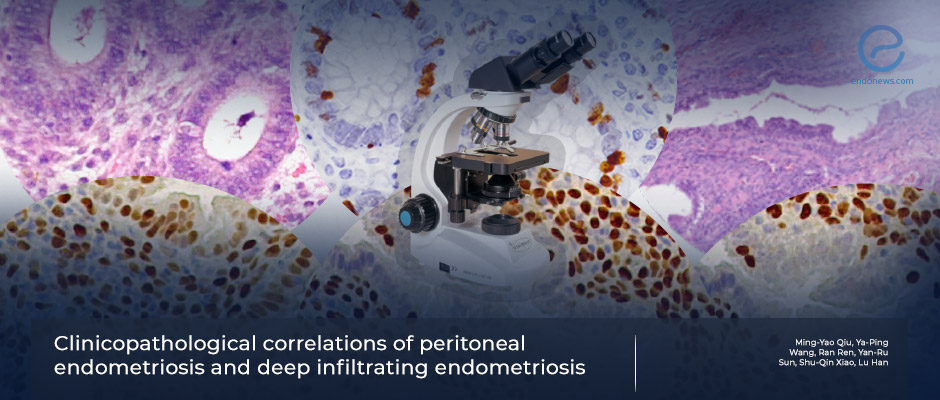A pioneering study on clinicopathologic features of biopsies of endometriotic lesions
Sep 19, 2023
Detailed histopathologic assessment of endometriosis biopsies
Key Points
Highlights:
- Endometriosis is a progressive disease, and different morphological appearance of endometriosis reflects different developmental stages.
- Ectopic endometrium has a destructive effect on peritoneal structures, it continuously infiltrates the sub-peritoneum during progressesion.
- Peritoneal and Deep infiltrating endometriosis should be different development stages of the same disease.
Importance:
- Clinicopathological correlations of the two types of endometriosis may yield important outcomes in the pathogenesis and management of endometriosis patients.
What's done here:
- A total of 100 patients with peritoneal endometriosis and deep infiltrating endometriosis were prospectively investigated, along with the histopathological characteristics.
- Hormone receptor expression and cell proliferation activity of different morphological features were also examined.
- The authors have also tried to find a correlation between peritoneal and deep infiltrating endometriosis in order to reach optimal management.
Key Results:
- The progression of peritoneal endometriosis has two outcomes: they remain inactively in the peritoneum or they progress and may progress to deep infiltrating endometriosis.
- These two endometriotic entities may represent different developmental stages of the same disease, but the homology between the two needs to be explored from pathogenetic evolution.
Limitation of the study:
- There has been only one gynecological pathologist mentioned in the present study reviewing the cumulative data which raises the question of being biased.
Lay Summary
Deep infiltrating endometriosis, where endometriotic lesions have an invasion depth of ≥5mm to the underlying tissues, is well known due to the troublesome features, peritoneal endometriosis is very common and widely distributed by superficial involvement in the pelvic visceral and mural peritoneal tissues.
Dr. Qiu and associates investigated the clinical and histopathological features of peritoneal endometriosis and deep infiltrating endometriosis in a total of 100 patients with endometriosis treated at Dalian Women and Children’s Hospital/Dalian Women and Children’s Medical Center between October 2018 and December 2021. One hundred and thirty-one peritoneal endometriosis and 37 deep infiltrating endometriosis biopsies were evaluated along with 22 samples from eutopic endometria. The present study mainly analyzed the pelvic distribution, the morphological, clinical, histopathological, and immunohistochemical features, and peritoneal invasion.
The posterior pelvis was the most common site for both peritoneal and deep endometriosis to hypothesize that the peritoneal lesions might be a pre-existing state of deep endometriosis. The analysis of different peritoneal lesions, such as red-brown and white lesions revealed that vesicular and transparent lesions appeared before red lesions, which belonged to the budding state of the disease, should be the first stage in the development of peritoneal endometriosis.
Estrogen and Progesterone receptors were highly expressed similarly, without statistical significance. The expression of proliferative marker Ki-67 in endometrioid glandular epithelium was higher in deep infiltrating endometriosis than in brown and white lesions of peritoneal endometriosis showing that deep endometriosis invades surrounding tissues similar to that of early lesions of peritoneal endometriosis.
The authors conclude that peritoneal lesions are progressive in their various morphological appearances that reflect different stages of their progression. Ectopic endometrial tissues possess destructive effects on peritoneal surfaces and the lesions seem to progress to invade the subperitoneal area. These two subtypes, namely peritoneal and deep infiltrating, are different development stages of the same condition, the homology of the two lesions has yet to be cleared in terms of pathogenetic stages of development.
This unique study was published in a recent issue of "Annals Of Medicine".
Research Source: https://pubmed.ncbi.nlm.nih.gov/37624743/
Peritoneal endometriosis deep infiltrating endometriosis histopathology

